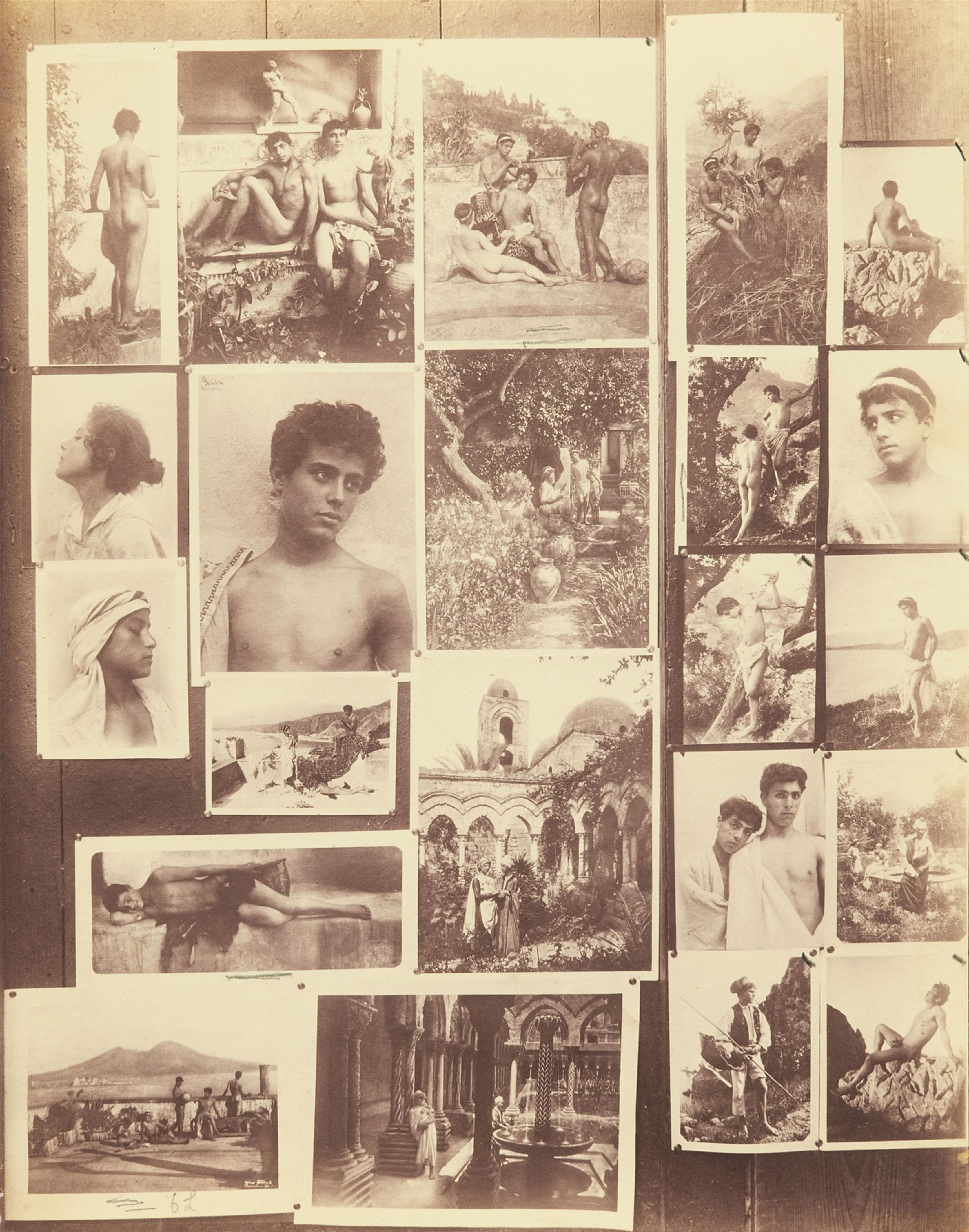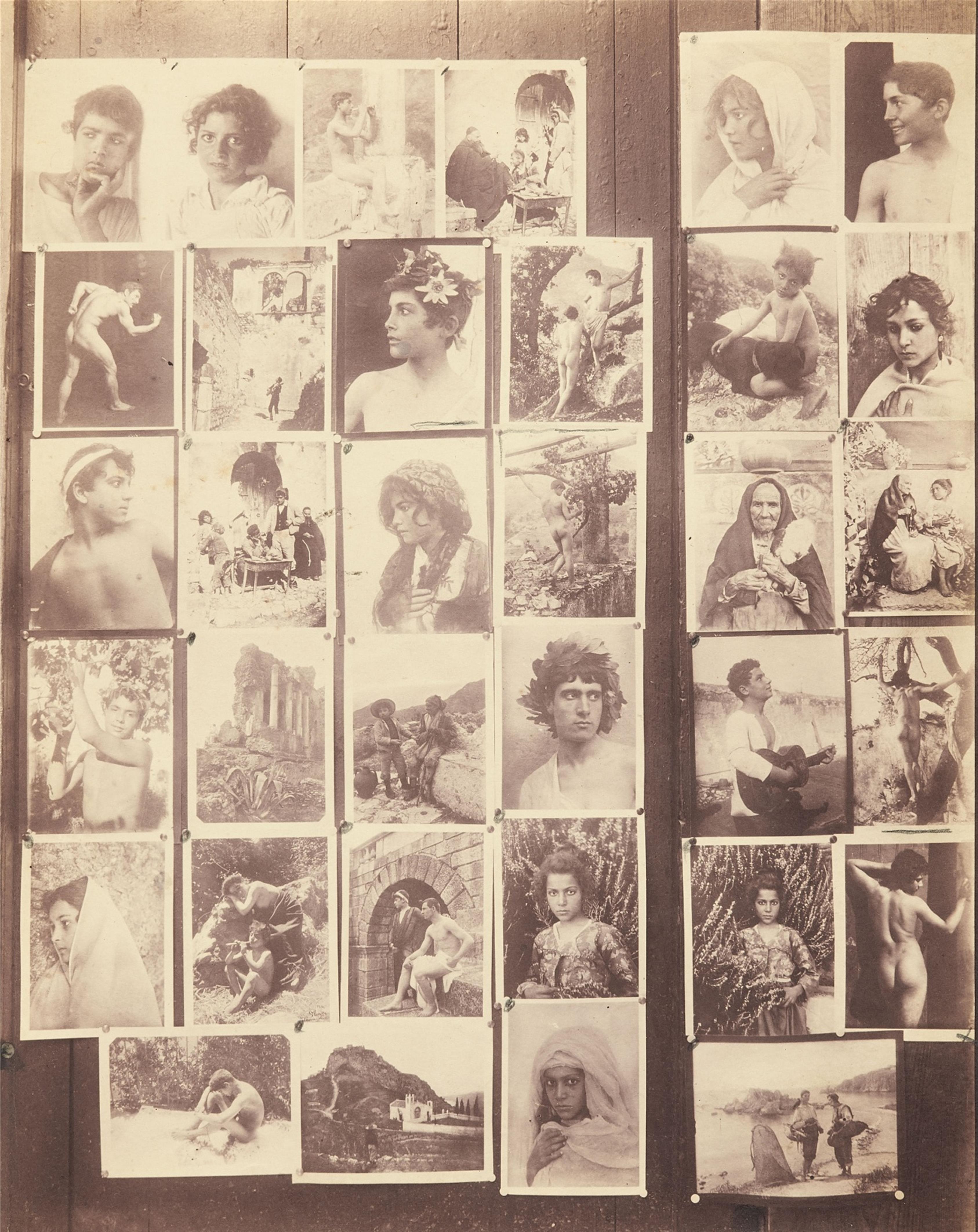Wilhelm von Gloeden
Untitled
c. 1900
2 albumen prints. 21 x 16.7 cm. 22.8 x 16.9 cm. Numbered 'M 1/6' and 'M 4/6' resp. in pencil on the verso.
“Collecting signifies not only the effective taking possession of an object, but the affectionate appropriation of the being captured in the picture.” (Heinz P. Barandun)
Wilhelm von Gloeden is considered the most prominent of the representatives of male nude photography at the end of the 19th century. His adopted home Taormina, the place where he settled in 1877/78 and opened his studio, became a "centre of the fashionable homoerotic society" of the Fin de siècle. Poets and actors, painters and outstanding personalities from politics, industry and the high nobility of the turn of the century, including Oskar Wilde and Gabriele d'Annunzio, Sarah Bernhardt and Marcel Proust, stopped over here. His open-air studies, mostly showing young people in antique-look garments in Arcadian landscapes, enjoyed great popularity even during his lifetime and could be acquired through art publishers as distribution partners and mail order catalogues (cf. lot 1). Thanks to the participation at numerous exhibitions and publications in important taste-influencing magazines, his works were internationally renowned.
The photographers Guglielmo (Wilhelm) Plüschow, a cousin of Gloedens, and Vincenzo Galdi, who first worked in Naples and since the mid-1890s in Rome, were equal in artistic terms, albeit far less popular during their lifetimes. The latter was a pupil and model of Plüschow and, like him, specialised in male nude portraits. Plüschow sometimes used the same photographic stylistic devices, props and models as Gloeden, which is why their works are often difficult to distinguish from each other. Peter Weirmair points out that Plüschow's works "have a stronger sexual charisma than Gloedens' works, which tend to omit the area of sexuality and are more romantically tinged".
Although the works presented here are exclusively photographs of young men who were, as Ulrich Pohlmann calls them, the "trademark" of the photographers, it would be insufficient to reduce Gloeden and his circle to the homoerotic aspect of their nudes. “The contemporary understanding was [...] more complex, especially as nude photography also represented the beginning of a successive liberation from the hostile dogmas regarding the body in the 19th century.” In photography until then, the male nude existed only in the often wooden-looking study templates for art-academic training or in pornographic photographs that were traded under the counter. The mere step into the open-air was a pioneering act of the photographers. The extraordinary quality of the works presented here is due to the balanced composition and the harmonious combination of landscape, figure and props. Together, they create the vivid impression of a real Arcadian world. “Customers were shocked by the realism of the bodies, which could not be aestheticised by attempts at idealisation, as was possible in the painting of someone such as Hans von Marées.” Contrary to the usual practice of contemporary nude photographers, Gloeden largely rejected manipulation of the negatives, thus "his open-air nudes, the high-definition of which emphasises every physical detail, occupy an exceptional position in nude photography around 1900”.
Heinz P. Barandun's interest in Wilhelm von Gloeden and his circle as well as the resulting passion for collecting was triggered by the reading of Roger Peyreflete's biographical novel 'Les amours singulières' (Paris 1949), a book which, as the collector himself puts it, "made a deep, lasting impression on his young mind”. Similarly to Peyrefitte, the French diplomat and pioneer of homosexual emancipation literature, Barandun spent many weeks in Sicily and Taormina in the following years and was able to make contacts that helped him to build up his collection. The Barandun Collection is one of the largest and most important collections of works by Wilhelm von Gloeden and his circle in private ownership. The greater part of the collection is from the estate of Wilhelm von Gloeden. It was initially in the possession of Pancrazio Bucini (known as 'Il Moro'), Gloedens' long-time assistant and friend, and after his death in 1963 was passed on to Nino Malambri, Taormina. Barandun acquired the prints he was interested in from Malambri in the 1980s. The collection was supplemented by targeted purchases at auctions, for example from Andy Warhol's estate, which was auctioned in New York in 1988. The Barandun Collection has been exhibited several times in parts, among others places in Rome, New York and on Capri. Most recently, the entire collection was presented in 2012 in a large exhibition in the Kunsthalle Memmingen, accompanied by an extensive catalogue.
Literature (selection):
Ulrich Pohlmann (ed.), Wilhelm von Gloeden. Sehnsucht nach Arkadien, exhib.cat. Fotomuseum im Stadtmuseum München, Berlin 1987
Peter Weiermeier, Guglielmo Plüschow, Cologne i.a. 1993
Peter Weiermeier, Wilhelm von Gloeden. Erotische Photographien, Cologne i.a. 1994
Italo Zannier (ed.), Wilhelm von Gloeden. Fotografie. Nudi. Paesaggi. Scene di Genere, exhib.cat. Palazzo della Ragione, Milan i.a., Florence 2008
Joseph Kiermeier-Debre/Fritz Franz Vogel (ed.), Wilhelm von Gloeden - auch ich in Arkadien. Die Sammlung Heinz Peter Barandun, exhib.cat. Kunsthalle Memmingen, Cologne 2008 (cited in the following: Kiermeier-Debre 2008)




